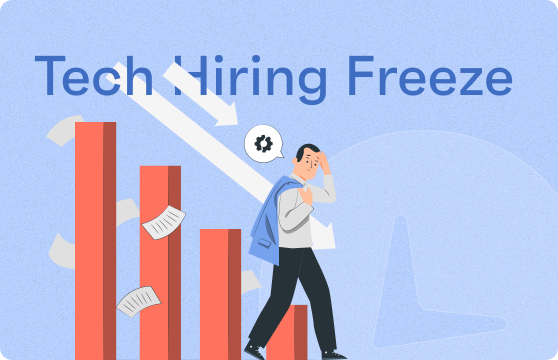The Tech Hiring Freeze and Slowdown: What It Means and How to Navigate It

Over the last several months, the tech industry has seen a noticeable hiring freeze and slowdown, a shift that has impacted both job seekers and employers. Once known for aggressive hiring practices and rapid growth, many tech companies are now taking a step back due to a combination of economic uncertainties, evolving market needs, and budget restrictions. For tech professionals and those involved in recruiting, this slowdown presents unique challenges, but also opportunities for growth and adaptation. Here’s a closer look at why this hiring slowdown is happening, what it means for the industry, and how companies and candidates can navigate this shift effectively.

Why is There a Hiring Freeze in Tech?
The hiring freeze in the tech industry is a result of multiple factors, each creating unique pressures on companies to slow or pause recruitment. Here are some of the major reasons why tech hiring is experiencing a pullback:
Economic Uncertainty
The global economy has faced headwinds such as inflation, supply chain issues, and geopolitical tensions. These uncertainties have pushed companies to rethink their growth strategies and, consequently, their hiring needs. With costs rising and profit margins narrowing, many companies are freezing or slowing down hiring to conserve cash.
Post-Pandemic Adjustments
The pandemic drove a massive shift to remote work and accelerated tech hiring to support these transitions. Now, as companies adapt to post-pandemic conditions, many are taking stock of their existing workforce and scaling back. Roles created to meet emergency needs during the pandemic are being reevaluated as companies optimize processes and consolidate responsibilities.
Market Saturation in Key Tech Areas
With significant growth in fields like artificial intelligence, e-commerce, and cloud computing, the competition has increased. Many large tech firms are recalibrating their workforce in response to increased competition and in preparation for the next big tech transformation. This means a shift from aggressive expansion to a more measured approach focused on optimizing current investments and talent.
Shift Toward Profitability
After years of rapid expansion, many tech companies, particularly startups, are now under pressure from investors to prioritize profitability over growth. This shift is causing a pullback in hiring, especially for roles focused on scaling and expansion. Companies are aiming to operate leaner, which often involves rethinking the roles needed to meet strategic goals.
What This Means for Tech Professionals
The hiring slowdown has unique implications for tech professionals seeking roles or building careers in the industry. Below are some key factors to consider as you plan your next moves:
- Increased Competition for Fewer Jobs: The hiring slowdown means that tech professionals, especially those in non-technical roles, are facing increased competition. Candidates need to stand out by highlighting relevant skills, accomplishments, and the potential for long-term impact.
- Focus on High-Demand Skills: Though hiring may be slowing in some areas, there remains a demand for talent in specialized, high-impact areas like cybersecurity, artificial intelligence, and data science. Professionals who invest in these skills, particularly those aligned with current market needs, may still find ample opportunities.
- The Rise of Contract and Freelance Work: As companies seek more flexibility, contract, freelance, and gig-based roles are on the rise. This shift offers tech professionals a chance to work on diverse projects while maintaining control over their career trajectories. It also allows companies to acquire talent on an as-needed basis, helping them adapt to economic conditions without making long-term commitments.
Maximize productivity of your business
Track employee productivity and simplify work with them
What It Means for Companies and Hiring Teams
For companies and hiring teams, the slowdown is an opportunity to refine strategies and focus on the most valuable hires. Here are a few areas where hiring priorities are shifting:
How to Adapt as a Job Seeker During a Hiring Slowdown

Job seekers in a hiring slowdown need to be strategic about their approach to the job market. Here are a few ways to increase your chances of success:
Upskill and Reskill Strategically
Now is a critical time for tech professionals to focus on skill development, particularly in areas that are expected to stay in demand. For example, proficiency in data science, machine learning, cloud computing, and cybersecurity can be significant differentiators in the job market. Investing in industry-recognized certifications can also be beneficial.
Leverage Networking and Relationships
During hiring slowdowns, networking becomes even more crucial. Referrals and networking can improve a candidate’s chances of landing a job by giving them a foot in the door. Consider reaching out to former colleagues, attending industry events, and engaging in online tech communities to increase your visibility and connections.
Be Open to Contract and Freelance Work
Contract work offers an opportunity to build experience, expand professional networks, and potentially turn short-term roles into long-term positions. This flexibility can be appealing for both job seekers and employers during a period of economic uncertainty.
Personal Branding and Visibility
A strong online presence can set a candidate apart. Optimizing LinkedIn profiles, creating a personal portfolio, and sharing insights or projects on social platforms can enhance visibility. During a slowdown, companies may be more selective, and having a professional, polished online presence can make a difference.
Hiring teams also need to adapt their strategies to meet the demands of a slower job market. Here are some tips for maximizing your recruiting impact:
Conclusion
The tech hiring freeze and slowdown reflect the current market’s cautious approach to growth and investment. While it presents challenges, both companies and job seekers can use this period as an opportunity for strategic growth and adaptation. For tech professionals, this may mean focusing on skill-building, networking, and flexibility in work arrangements. For companies, it’s about refining hiring processes, investing in high-impact roles, and building a strong employer brand. By taking these steps, tech professionals and hiring teams alike can navigate the current landscape effectively, setting themselves up for success when growth resumes.
– The Monitask Team
Frequently Asked Questions
Is the hiring slowdown affecting all tech roles equally?
No, while some roles are affected, high-demand positions in cybersecurity, AI, data science, and cloud computing continue to see strong demand. Companies are prioritizing roles that align with core business needs and long-term growth.
What should job seekers focus on during this slowdown?
Job seekers should focus on upskilling in high-demand areas, networking, and exploring contract work for flexibility. Maintaining a strong online presence and positioning themselves as adaptable professionals can also increase visibility.
How can companies benefit from this hiring slowdown?
Companies can use the slowdown to refine hiring processes, build a strong employer brand, and focus on quality over quantity in hiring. A more streamlined approach helps attract top talent and prepares the company for future growth when the economy stabilizes.



